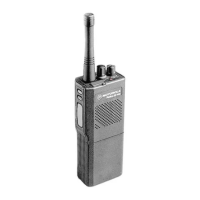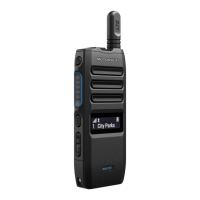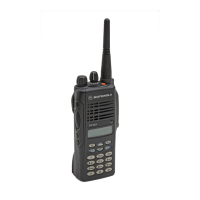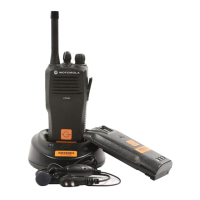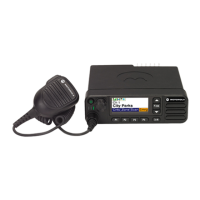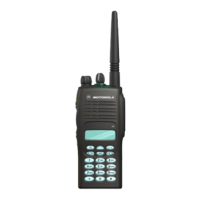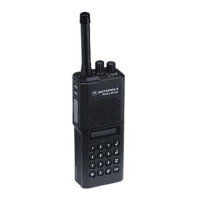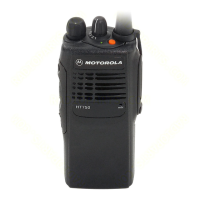5-4 435 – 480 MHz UHF2 Theory of Operation: UHF2 Transmitter
5.3.1 Power Amplifier
The transmitter power amplifier has three stages of amplification – Pre Driver (Q401), Driver
Amp (Q402) and Final Amp (Q403). Signal from TX VCO is applied to the pre driver via an attenuator
circuit. The attenuator is pie style resistor attenuator, and is used as isolation between VCO and the
power amps. The -4dBm TX RF signal from attenuator is then amplified by pre driver and driver amp
to around +25dBm and is applied to the final amp. The final amp (Q403) is an enhancement-mode
N-channel MOSFET device providing a gain of 12 dB. The device drain current is drawn directly from
the DC battery supply voltage input via L413.
UHF2
A matching network consisting of C416 – C420, and a strip line, transforms the impedance to
approximately 50 Ohm.
UHF2 R&TTE
A matching network consisting of C416 – C418, C420, C451, C452, and a strip line, transforms the
impedance to approximately 50 Ohm.
5.3.2 Antenna Switch
An antenna switch works mainly as a switching device between transmit and receive paths. In
transmit mode (PTT), Q407 is turned on and both PIN diodes (CR401, CR301) are forward biased
into conduction. This enables the RF signal to pass to the harmonic filter and then to the antenna. In
the receiver mode, both diodes are off. Signals applied to the antenna jack are routed via the LPF
(harmonic filter), through network L409 – L411, to the receiver input.
5.3.3 Harmonic Filter
UHF2
The harmonic filter consists of components L409 – L411, C426 – C430, C445, and C446. The
harmonic filter is a seven-pole elliptic filter.
UHF2 R&TTE
The harmonic filter consists of components L409 – L411, C426 – C429, C445, and C446. The
harmonic filter is a seven-pole elliptic filter.
5.3.4 Auto Power Control
The APC keeps the current supply constant to the final amp (Q403). The drain current of Q403 (final
amp) is sensed across resistor R417. The voltage difference across R417 is amplified through U401
by the ratio of R423 to R417. The differential signal at the output of U401 (Pin 7) is passed to Q404
and Q405 that produces a constant power output to the antenna. If the current is changed due to
change of battery voltage or load, APC controls gate voltage of Q403 and collector voltage of Q401
and drain voltage of Q402 to keep TX power stable. This circuit stabilizes TX power at a
pre-determined level adjusted by U402. This bias voltage is tuned in the factory. If the transistor
(Q403) is replaced, the RF Output Power must be tuned. By tuning the RF output power, the bias
voltage will be tuned through U402. Extra care has to be taken during the tuning process. Do not
exceed the maximum allowed bias voltage.
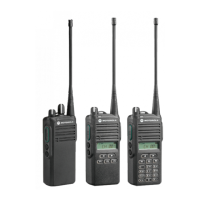
